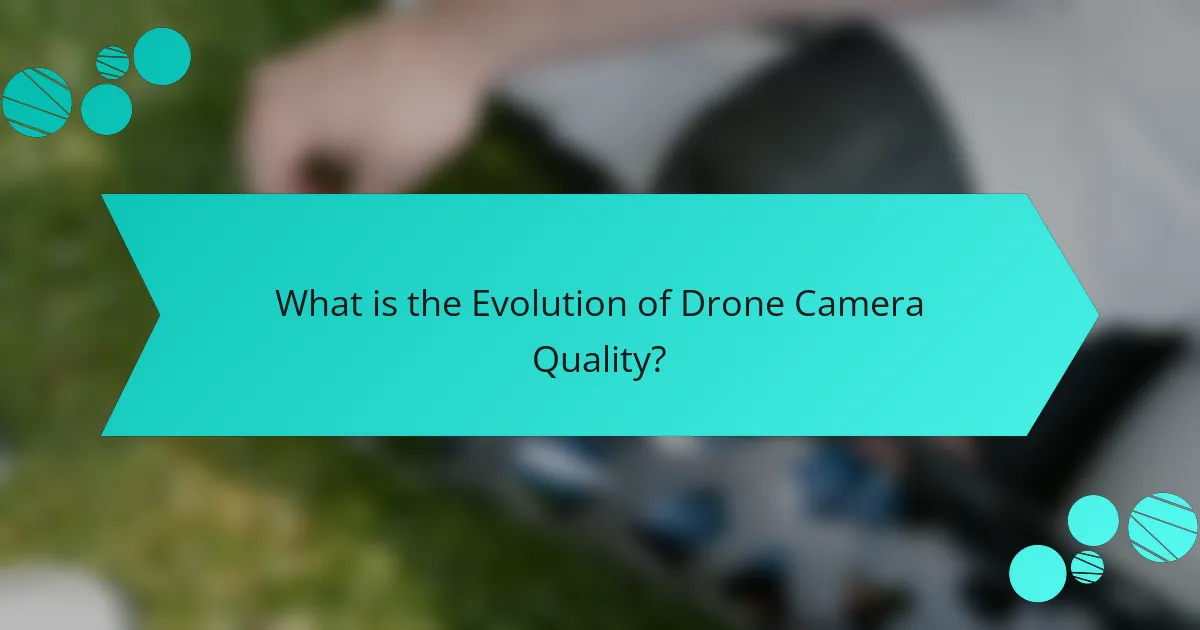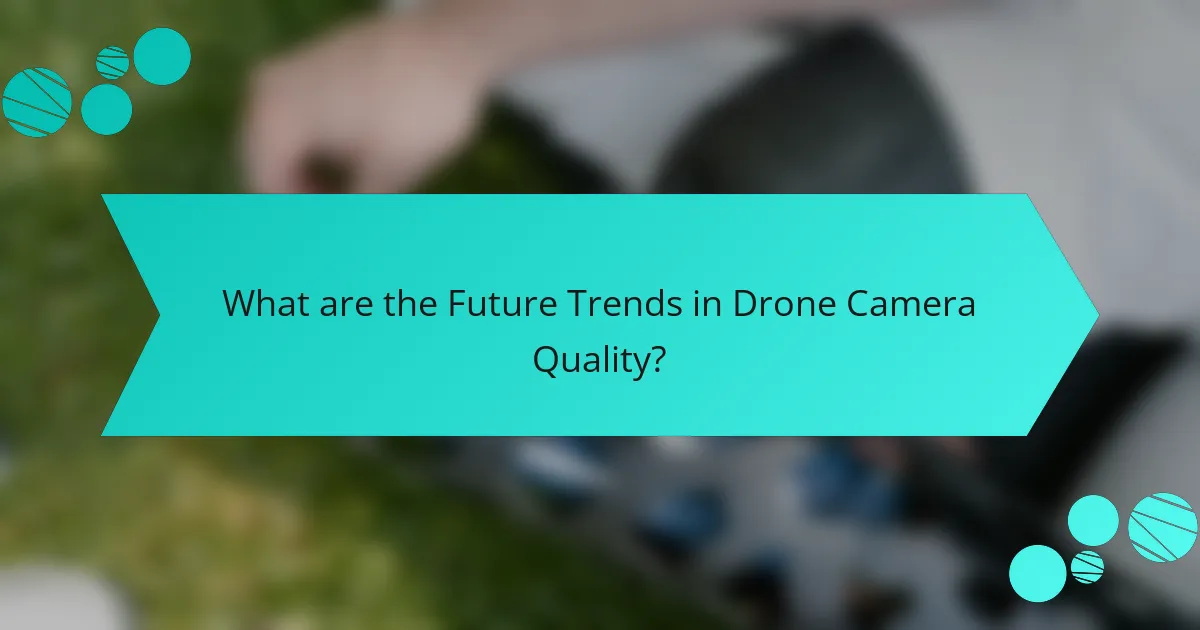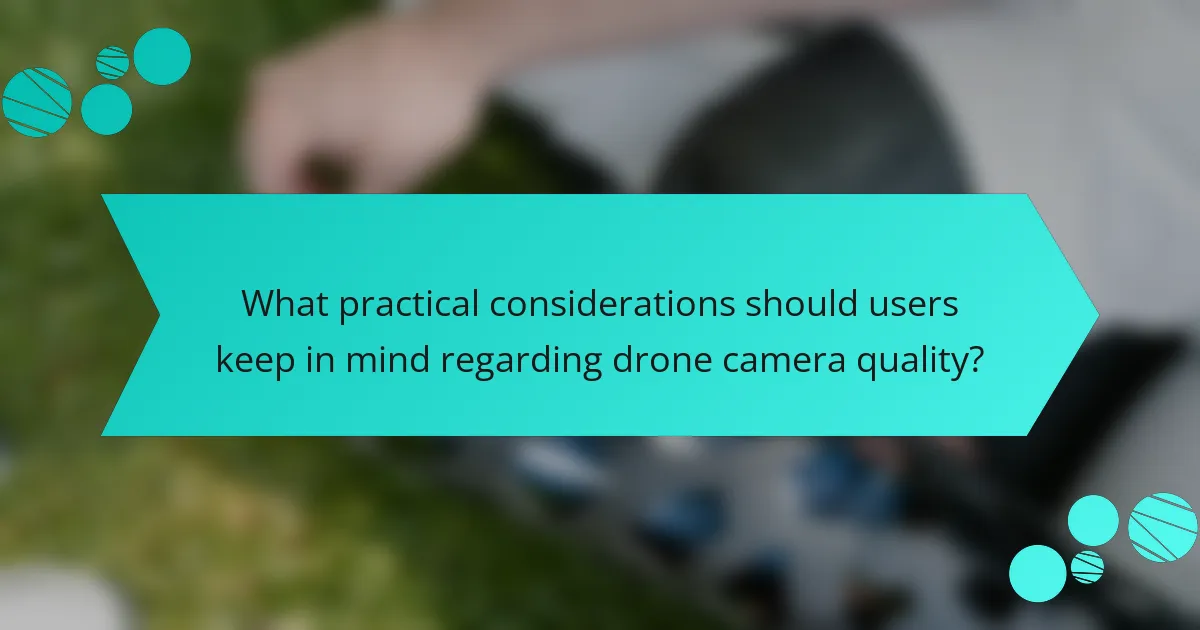
What is the Evolution of Drone Camera Quality?
Drone camera quality has evolved significantly over the past decade. Early drones featured low-resolution cameras, often around 720p. As technology advanced, 1080p cameras became standard in consumer drones. The introduction of 4K cameras marked a major milestone, offering four times the resolution of 1080p. Recent models now include 6K and 8K capabilities, enhancing detail and clarity. Additionally, advancements in stabilization technology improved video quality. Features like HDR and improved low-light performance have also emerged. These developments have transformed drone photography and videography. The integration of AI in camera systems further enhances image quality and user experience.
How has drone camera technology developed over the years?
Drone camera technology has significantly advanced over the years. Initially, early drones had basic cameras with limited resolution. The first consumer drones, released in the early 2000s, featured low-quality imaging capabilities. As technology progressed, manufacturers began integrating higher resolution cameras. By 2010, drones with 720p HD cameras became available.
In 2015, 4K video recording became standard in many consumer drones. This advancement allowed for higher detail and clarity in aerial footage. Additionally, advancements in gimbal stabilization improved image quality by reducing vibrations.
Recent developments include the integration of AI for enhanced image processing. Modern drones now offer features like obstacle avoidance and automated tracking. The evolution of drone camera technology has led to widespread use in industries such as filmmaking, agriculture, and surveillance.
What were the early innovations in drone camera technology?
Early innovations in drone camera technology included the integration of lightweight cameras and stabilization systems. The introduction of the GoPro camera in 2009 allowed for high-quality video capture on drones. This marked a significant shift in aerial photography. Additionally, the development of gimbal technology improved stability during flight. These advancements enabled smoother footage and clearer images. Early drones also utilized basic remote control systems for operation. The combination of these technologies laid the foundation for modern drone photography. As a result, the industry saw rapid growth and increased accessibility for consumers and professionals alike.
How did the introduction of HD cameras change the landscape?
The introduction of HD cameras significantly enhanced image quality and detail in photography and videography. This advancement allowed for clearer visuals, improving both professional and consumer content. HD cameras provided a resolution of 720p or higher, which was a substantial upgrade from standard definition. This increased clarity enabled filmmakers and content creators to capture more intricate details. The rise of HD cameras also spurred the growth of platforms that support high-definition content, such as YouTube and streaming services. As a result, audiences began to expect higher quality visuals in media. This shift influenced the design and capabilities of drones, integrating HD cameras to meet consumer demand. In 2010, HD cameras became more accessible, leading to a boom in aerial photography and videography. The impact of HD cameras reshaped the landscape of visual media, setting new standards for quality and creativity.
What are the key technological advances in drone cameras?
Key technological advances in drone cameras include improved image sensors, enhanced stabilization systems, and advanced AI capabilities. Modern drones now utilize larger sensors, such as 1-inch CMOS sensors, which capture higher resolution images and perform better in low light. Enhanced stabilization systems, like gimbals with 3-axis control, significantly reduce motion blur and improve video quality. AI capabilities enable features like object tracking, automated flight paths, and real-time image processing. These advancements allow for more precise aerial photography and videography. Additionally, the integration of 4K and 8K video recording has become standard in high-end drones, providing exceptional video clarity. The development of thermal imaging and multispectral cameras has expanded the applications of drone technology in fields like agriculture and search and rescue.
How do sensor improvements impact image quality?
Sensor improvements enhance image quality by increasing resolution, dynamic range, and low-light performance. Higher resolution allows for more detail in images, resulting in clearer and sharper visuals. Improved dynamic range captures a broader spectrum of light, preserving details in both highlights and shadows. Enhanced low-light performance reduces noise and improves clarity in darker environments. For example, modern sensors can achieve ISO levels up to 102,400, significantly outperforming older models. These advancements lead to more professional-grade images, making drones suitable for various applications like aerial photography and surveillance.
What role does stabilization technology play in drone cameras?
Stabilization technology is crucial for drone cameras as it minimizes unwanted movements. This technology ensures smooth video footage and clear images during flight. It compensates for vibrations and turbulence caused by wind or drone maneuvers. Advanced stabilization systems, like gimbals, allow cameras to remain level even when the drone tilts. This results in professional-quality footage, essential for filmmakers and photographers. According to a study by DroneDJ, drones equipped with stabilization technology produce videos that are 30% smoother than those without. Enhanced stabilization improves the overall user experience and expands the creative possibilities for aerial photography.
Why is historical comparison important in understanding drone camera evolution?
Historical comparison is important in understanding drone camera evolution because it highlights technological advancements over time. By examining past models, we can identify improvements in image quality, sensor technology, and stabilization features. For instance, early drone cameras had limited resolution and functionality. In contrast, modern drones offer 4K video and advanced imaging capabilities. Historical data also reveals user needs and market trends that shaped development. Analyzing these changes helps predict future innovations. Such comparisons provide context for current capabilities and inform expectations for upcoming technologies.
How do past models compare to today’s drone cameras?
Past drone camera models typically featured lower resolution and limited stabilization compared to today’s models. Early drones often captured images at 720p or lower. In contrast, modern drones can shoot in 4K and even 8K resolution.
Additionally, older models had basic stabilization systems, resulting in shaky footage. Today’s drones utilize advanced gimbal technology for smooth video capture.
Battery life has also improved significantly. Early drones had flight times of around 10-15 minutes. Current models often exceed 30 minutes of flight time.
The integration of AI and automated features in modern drones enhances usability and image quality. Past models lacked these intelligent capabilities.
Overall, advancements in sensor technology, image processing, and flight stability have made today’s drone cameras far superior to their predecessors.
What lessons can be learned from historical advancements?
Historical advancements teach us the importance of innovation and adaptation. Each technological leap has led to improved efficiency and capabilities. For instance, the development of film photography laid the groundwork for modern digital imaging. The transition from analog to digital cameras revolutionized the photography industry. Similarly, early drone technology has evolved significantly, enhancing aerial photography quality. Lessons from history emphasize the need for continuous research and development. They also highlight the value of learning from past mistakes to avoid repeating them. Understanding these lessons can guide future advancements in drone camera technology.

What are the Future Trends in Drone Camera Quality?
Future trends in drone camera quality include higher resolution sensors and improved low-light performance. Manufacturers are increasingly adopting 8K video capabilities. This advancement allows for more detailed imagery in various conditions. Enhanced stabilization technologies are also being developed. These technologies reduce motion blur and improve image clarity. Additionally, AI integration is on the rise. AI can optimize image processing and enhance real-time decision-making. Improved lens technology is another focus area. Lenses with wider apertures will capture better images in challenging environments. Finally, there is a growing emphasis on compact designs. Smaller cameras will offer high quality without adding significant weight to drones.
How will AI and machine learning influence drone camera technology?
AI and machine learning will significantly enhance drone camera technology. These technologies will improve image processing capabilities. Drones will be able to automatically analyze and interpret visual data. This leads to better object recognition and tracking in real-time. For instance, machine learning algorithms can classify images for various applications, such as agriculture and surveillance. AI can also optimize flight paths based on environmental data. This increases efficiency and reduces energy consumption. Studies show that AI-driven drones can improve aerial imaging accuracy by up to 30%. Overall, AI and machine learning will revolutionize how drone cameras operate and interact with their environment.
What advancements in image processing can we expect?
Advancements in image processing will focus on improved algorithms and machine learning techniques. These enhancements will lead to better image clarity and detail. Real-time processing capabilities will increase, allowing for immediate feedback. Enhanced noise reduction methods will improve image quality in low-light conditions. 3D imaging and depth perception will become more sophisticated. Integration with artificial intelligence will enable smarter image analysis. Increased computational power will facilitate complex processing tasks. These trends are supported by ongoing research in computer vision and neural networks.
How might autonomous features enhance drone photography?
Autonomous features can significantly enhance drone photography by enabling advanced flight capabilities. These features include automated tracking, obstacle avoidance, and intelligent flight planning. Automated tracking allows drones to follow subjects seamlessly, capturing dynamic shots without manual control. Obstacle avoidance systems enhance safety, preventing collisions during complex maneuvers. Intelligent flight planning optimizes routes for capturing the best angles and lighting conditions. Research indicates that drones with autonomous features can reduce pilot workload and improve image consistency. According to a study by the International Journal of Advanced Drone Technology, drones with autonomous capabilities achieve a 30% increase in photo quality due to optimized flight paths.
What emerging technologies are shaping the future of drone cameras?
Emerging technologies shaping the future of drone cameras include artificial intelligence, enhanced sensors, and improved battery technology. Artificial intelligence enables real-time image processing and autonomous navigation. Enhanced sensors, such as LiDAR and thermal imaging, provide higher resolution and versatility. Improved battery technology extends flight times and operational range. These advancements are backed by ongoing research and development in the field. For instance, AI-driven drones can analyze footage instantly, making them valuable for various applications. The integration of these technologies is revolutionizing the capabilities and efficiency of drone cameras.
How will 5G connectivity impact drone camera capabilities?
5G connectivity will significantly enhance drone camera capabilities. It will enable real-time data transmission with minimal latency. This improvement allows for high-definition video streaming from drones. Drones can transmit 4K or even 8K video in real-time. The increased bandwidth supports multiple drones operating simultaneously without interference. Enhanced connectivity will also facilitate advanced features like obstacle detection and automated navigation. With 5G, drones can process and analyze data on the fly. This capability leads to improved decision-making during flight operations.
What innovations in battery technology could improve drone performance?
Solid-state batteries could significantly improve drone performance. They offer higher energy density compared to traditional lithium-ion batteries. This means drones can fly longer on a single charge. Solid-state batteries also have improved safety features. They are less prone to overheating and fires. Additionally, advancements in fast-charging technology can reduce downtime. Some solid-state batteries can charge in under 30 minutes. These innovations collectively enhance the operational efficiency of drones. As a result, drones can perform more complex tasks over extended periods.

What practical considerations should users keep in mind regarding drone camera quality?
Users should consider several factors regarding drone camera quality. Resolution is critical; higher megapixels yield clearer images. Lens quality affects sharpness and distortion levels. Sensor size influences light sensitivity and dynamic range. Frame rate is important for video smoothness; higher rates capture fast movements better. Gimbal stabilization minimizes shake, enhancing video quality. Battery life impacts shooting duration; longer life allows for more extensive captures. Weather conditions can affect performance; drones should be used in suitable environments. Lastly, user experience with settings and controls can improve overall output quality.
What are the best practices for choosing a drone camera?
The best practices for choosing a drone camera include assessing camera resolution, considering lens quality, and evaluating stabilization features. Higher resolution cameras, such as those with 4K capabilities, provide better image quality. Lens quality affects the clarity and sharpness of photos and videos. A gimbal stabilization system is crucial for smooth footage during flight. Additionally, check the camera’s low-light performance for versatility in different lighting conditions. Battery life is another important factor, as longer flight times allow for more shooting opportunities. Finally, ensure the camera is compatible with your drone model for optimal performance.
How can users optimize camera settings for different environments?
Users can optimize camera settings for different environments by adjusting exposure, ISO, and white balance. In bright environments, users should decrease exposure and ISO to avoid overexposure. In low-light settings, increasing ISO helps capture more light, but it may introduce noise. Users should set the white balance according to the lighting conditions. For daylight, a daylight setting works best. In artificial light, adjusting to tungsten or fluorescent settings can improve color accuracy. Additionally, using manual focus in complex environments ensures sharp images. Each adjustment enhances image quality based on specific environmental conditions.
What maintenance tips can help prolong the life of a drone camera?
Regularly cleaning the drone camera lens helps maintain image quality. Use a microfiber cloth to gently wipe the lens. Avoid using abrasive materials that can scratch the surface. Storing the drone in a protective case prevents dust accumulation. Ensure the camera is dry before storage to avoid moisture damage. Regularly check for firmware updates to enhance performance. Calibrate the camera settings before flights for optimal results. Inspect the camera for any physical damage after each flight. Following these tips can significantly extend the lifespan of a drone camera.
What common challenges do users face with drone camera quality?
Users commonly face issues with drone camera quality such as low resolution, poor low-light performance, and limited dynamic range. Low resolution can result in pixelated images, especially when zooming in. Poor low-light performance affects image clarity in darker environments. Limited dynamic range can cause loss of detail in bright highlights and dark shadows. Additionally, users may encounter problems with image stabilization, leading to shaky footage. Battery life limitations can also restrict the time available for capturing high-quality images. Finally, the lens quality and field of view can impact the overall image sharpness and perspective.
How can users troubleshoot common image quality issues?
Users can troubleshoot common image quality issues by checking the camera settings and ensuring optimal configurations. First, verify that the resolution is set to the highest available option. Next, check the lens for dirt or obstructions that may cause blurriness. Adjust the exposure settings to prevent overexposure or underexposure. Users should also ensure that the drone’s firmware is up to date, as updates can improve image processing. Additionally, examine the lighting conditions; shooting in low light can affect quality. Finally, review the storage medium for speed and capacity, as slow memory cards can lead to dropped frames or lower quality images.
What resources are available for further learning about drone cameras?
Online courses are available for further learning about drone cameras. Platforms like Udemy and Coursera offer specialized courses. These courses cover drone photography, videography, and camera settings. Books on drone technology also provide in-depth information. Titles such as “The Drone Camera Handbook” offer practical insights. YouTube channels dedicated to drone reviews and tutorials are valuable resources. Websites like DroneDJ and DJI’s official site feature articles and guides. Forums like Reddit’s r/drones allow for community discussions and advice. These resources collectively enhance understanding of drone camera technology.
The main entity of the article is drone camera quality, which has undergone significant evolution over the past decade. The article explores technological advances such as the transition from low-resolution cameras to 4K, 6K, and 8K capabilities, alongside improvements in stabilization technology and AI integration. It provides historical comparisons that highlight the advancements in image quality, sensor technology, and stabilization features, while also discussing future trends like enhanced sensors and 5G connectivity. Practical considerations for users regarding camera settings, maintenance, and troubleshooting common issues are also addressed, offering a comprehensive overview of the current and future landscape of drone camera technology.



